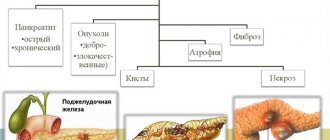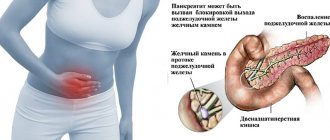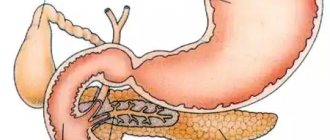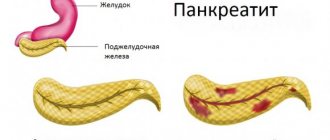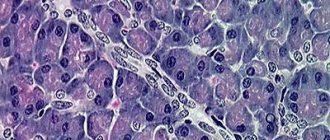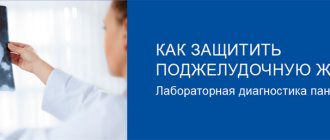The prescription of antibiotics for pancreatitis is associated with a combination of inflammation caused by the release of excess enzymes that melt the tissue with an associated infection from the intestines and gallbladder.
In this case, the risk of infection increases significantly and pancreatitis is complicated by a septic condition, peritonitis, retroperitoneal abscess or phlegmon. Severe inflammation of the pancreas is observed in every fifth case. Only a doctor can determine which drug should be taken in a particular case.
When are antimicrobials appropriate?
Antibacterial drugs should be treated with due attention due to possible side effects and inhibition of intestinal flora. Therefore, there must be clear indications for prescribing antibiotics. These include:
- obtaining, during examination, indisputable data on the inflammatory process in glandular tissues, neighboring organs (cholecystitis), and intestines;
- bile stagnation, dyskinesia of the gallbladder and ducts;
- the risk of spreading infection and bacterial complications, which increases in the presence of cholangitis, cysts in the body of the gland, pancreatic necrosis;
- suspicion of rupture of the main duct in the glandular tissue;
- the appearance of signs of peripancreatitis (inflammation in surrounding tissues).
Currently, it is prohibited to use antibiotics for prophylactic purposes.
The pancreas is connected by blood circulation to neighboring organs; the infection can spread by contact along the common duct, bile ducts
Advantages and disadvantages of antibiotics
The selection of antibiotics requires knowledge of the mechanism of action. It is impossible to suppress pathogenic flora with other drugs. Lost time will lead a patient with acute pancreatitis to necrosis and death from severe intoxication, which is almost impossible to cope with with other medications.
Negative manifestations include:
- the possibility of developing hypersensitivity with allergic manifestations (skin rash, itching, swelling of the face, runny nose, asthma attack);
- toxic effect on the liver and kidneys when the dosage is exceeded, while the patient is taking alcoholic beverages;
- undesirable enhancement of the effect of other medications that the patient is taking (for example, blood thinners);
- dizziness, nausea, hearing impairment are often caused by the effect of antibiotics on the vestibular apparatus of the brain;
- An imbalance in the intestinal flora leads to the need to take probiotics and prebiotics after a course of antibiotics to restore digestion.
Antibiotics are a special type of medicine. They are obtained from natural or synthetic raw materials. Act on living microorganisms. Different classes differ in the mechanism of influence. The most powerful agents kill pathogenic microbes.
Others disrupt metabolism, the construction of cell membranes, and thereby disorganize metabolism to such an extent that they create conditions unacceptable for the life of the microbe.
Unfortunately, drugs can also affect the necessary microflora, cells of the nervous system, liver, and kidneys. Toxic substances hinder the functioning of human internal organs, cause poisoning and require additional cleansing of the body.
The disadvantages of antibiotic treatment include the possibility of causing resistance in pathogenic flora. Rather, this is a matter of microorganisms becoming accustomed, but as a result, entire classes of possible drugs are lost. The problem of resistance is being studied by scientists around the world.
Like other medications, antibiotics have the potential to cause an allergic reaction in an individual patient. With a high frequency of allergenicity, drugs are excluded from practice.
Before using an antibiotic, it is necessary to perform a sensitivity test to prevent possible allergies.
Rules for the use of antibiotics
Treatment of pancreatitis with antibiotics is carried out in accordance with the general rules of therapy. If there is no data on the microorganisms that caused the inflammatory process, broad-spectrum drugs are prescribed. Upon receiving the conclusion of the flora analysis, the most optimally effective antibiotic is used.
Before use, an intradermal test is performed to identify increased sensitivity of the body and prevent an allergic reaction. The dosage is calculated based on the weight and age of the patient.
Antibiotics for pancreatitis in adults and children are prescribed in a course of 7–10 days; by independently shortening or extending the treatment period, patients cause irreparable harm to their body, since sensitivity to the chosen drug is lost.
It is necessary to take into account the compliance of the form of administration with the patient’s condition; in severe cases, only the injection method is recommended (intramuscular and intravenous) due to vomiting, low absorption in the intestine; patients drink tablet medications when their condition improves.
The frequency of doses is due to the need to maintain a constant sufficient therapeutic dosage in the body, so the doctor is guided by data on the rate of accumulation and elimination. The principle of drug interaction, strengthening or opposite direction of influence is taken into account.
Antibiotics that have a high toxic effect on the liver and kidneys are not used. Antibacterial drugs are used in a comprehensive treatment regimen.
The doctor can judge the presence of an infectious complication by the patient’s fever and increased pain.
Prescription of several drugs must be monitored for their combined effect
Antibiotics for acute pancreatitis
Pathological changes in acute pancreatitis begin with stagnation of secretions containing powerful enzymes inside the glandular tissue and the development of self-digestion of the organ. In response, immune cells accumulate in the peritoneum, providing aseptic (without the participation of microbes) inflammation to limit the process.
Pancreas examination
But conditionally pathogenic microorganisms (Escherichia coli) located nearby in the intestine, taking advantage of the weakening of their protective properties, turn into serious causative agents of infectious inflammation and complicate the course of pancreatitis.
The human body requires additional efforts to fight, which it does not have. In such a situation, only antibacterial agents can help. Broad-spectrum drugs are used. They are administered intravenously and intraperitoneally.
In an acute process, the effectiveness of treatment and the outcome of the disease largely depend on the initiation of antibiotic treatment. Delayed use threatens the patient's life.
Application of No-shpa
No-shpa - the drug has an antispasmodic effect.
In acute pancreatitis, patients experience severe pain that must be eliminated. For this purpose, No-shpa is used, which have a pronounced therapeutic effect.
No-spa has a pronounced antispasmodic effect. The use of traditional medicine is carried out if the patient experiences spasms in the intestines or stomach.
Also indications for the use of pharmaceutical medicine are urolithiasis and cholelithiasis. Doctors prescribe pharmaceutical medicine to patients diagnosed with angina or spasmodic constipation.
The traditional medication is taken orally 2 to 3 times a day. A single dose of the drug ranges from 0.04 to 0.08 grams. You can also administer a two percent solution of the drug intravenously at 2-4 milligrams. If the patient has obliterating endarteritis, then the traditional medication must be injected into the artery.
Despite the high effectiveness of No-shpa, it can cause side effects if taken incorrectly. In most cases, patients complain of dizziness and rapid heartbeat.
In some patients, undesirable effects manifest themselves in the form of constipation, increased sweating, and a feeling of heat. Taking pharmaceutical medications can lead to allergic dermatitis.
No-spa is a highly effective medicine that fully copes with spasms in acute pancreatitis.
Why are antibiotics needed for chronic pancreatitis?
Chronic pancreatitis is less severe, but each exacerbation is accompanied by increased activity of pathogenic microflora and invades new areas of the pancreas. In this case, the gallbladder, ducts, duodenum, stomach, and liver are involved in the inflammatory process.
The surrounding tissues are the first to be affected (peripancreatitis). In such cases, it is necessary to provide active counteraction to microorganisms.
Drugs are prescribed in the acute stage:
- Ampioks,
- Augmentin,
- Amoxicillin,
- Amoxiclav,
- Levomycetin,
- Cefoperazone,
- Cefuroxime,
- Cefixime.
The effectiveness is judged by the normalization of temperature, absence of pain, and restoration of stool. Before use, it is advisable to isolate the most significant pathogen or mixed microflora by bacteriological method to select the optimal antibiotic. Sowing of bile and gastric juice is carried out. Sensitivity to the drug must be confirmed.
If there is no evidence of infectious inflammation, then there is no point in prescribing antibiotics; treatment is carried out with enzyme and other drugs
Amoxicillin
Inside, before or after meals.
Adults and children over 10 years of age (weighing more than 40 kg) are prescribed 250 mg 3 times a day; for severe infection - 500 mg 3 times a day.
For children under 10 years of age, the drug is prescribed in the form of a suspension, since at this age dosing the drug in capsules is difficult.
The interval between each dose of 8 hours must be strictly observed.
The maximum daily dose should not exceed 6 g.
The course of treatment is 5-12 days. It is recommended to continue treatment for 48-72 hours after body temperature has returned to normal or after the pathogen has been effectively destroyed.
Infections of the upper respiratory tract and ENT organs (sinusitis, pharyngitis, tonsillitis, acute otitis media): 250 mg every 8 hours.
Lower respiratory tract infections (acute and chronic bronchitis, pneumonia): 500 mg every 8 hours.
Acute uncomplicated infections of the genitourinary system: high-dose therapy is recommended: 2 doses of 3 g each with an interval of 10-12 hours.
For acute uncomplicated gonorrhea, men are prescribed 3 g once; when treating women, it is recommended to take the indicated dose twice with an interval of 10-12 hours due to the possible multiple nature of the lesion and an ascending inflammatory process with transition to the pelvic organs.
Gynecological infections without fever: 250 mg every 8 hours.
Gynecological infections accompanied by fever: 1.5-2 g 3 times a day or 1-1.5 g 4 times a day.
Infections of the gastrointestinal tract (enterocolitis, typhoid fever, shigellosis): 1.5-2 g 3 times a day or 1-1.5 g 4 times a day.
Salmonella carriage: 1.5-2 g 3 times a day for 2-4 weeks.
Peptic ulcer of the stomach and duodenum, chronic gastritis associated with Helicobacter pylori as part of combination therapy: 1 g 2 times a day.
Biliary tract infections (cholangitis, cholecystitis): 1.5-2 g 3 times a day or 1-1.5 g 4 times a day.
Skin and soft tissue infections (erysipelas, impetigo, secondary infected dermatoses): 250 mg every 8 hours.
Leptospirosis: 500 mg-750 mg 4 times a day for 6-12 days.
Lyme disease (borreliosis): for stage I of the disease, 500 mg 3 times a day.
Infectious endocarditis, for example, enterococcal: for the prevention of endocarditis during minor surgical interventions in adults - 3-4 g 1 hour before the procedure. If necessary, a repeat dose is prescribed after 8-9 hours.
Patients with severe renal impairment should reduce the dose or increase the interval between doses of amoxicillin.
When creatinine clearance is below 10 ml/min and for patients on peritoneal dialysis, the maximum daily dose is 500 mg (250 mg 2 times a day); with a creatinine clearance of 10-30 ml/min, the maximum daily dose is 1000 mg (500 mg 2 times a day); if creatinine clearance is more than 30 ml/min, no dosage adjustment is required; for anuria - the maximum dose should not exceed 2 g/day.
For children aged 5-10 years, the dose is calculated per kilogram of the child’s weight. In pediatric practice, Amoxicillin in capsule form is applicable if the daily dose is at least 500 mg taken twice a day (250 mg 2 times a day).
For a child weighing less than 20 kg, the daily dose is 25 mg/kg/day, divided into 3 doses; for severe disease - 50 mg/kg/day, divided into 3 doses.
For a child with a body weight in the range of 20-40 kg, amoxicillin is prescribed at a dose of 40-90 mg/kg/day in 3 divided doses at low doses and in 2 divided doses at high doses.
For children weighing more than 40 kg, the drug is prescribed based on the dosage regimen for adults.
Tonsillitis: 50 mg/kg/day in 3 divided doses.
Acute otitis media: in severe cases and relapses, 750 mg 2 times a day for 2 days can be used as an alternative treatment regimen.
Prevention of endocarditis: 1.5 g 1 hour before surgery as a single dose. For surgical interventions performed under general anesthesia - 1.5 g 4 hours before surgery as a single dose. If necessary, re-administer after 6 hours.
For children with impaired renal function with creatinine clearance less than 10 ml/min, the interval between doses should be increased to 24 hours, which corresponds to taking 1/3 of the usual dose; with creatinine clearance in the range of 10-30 ml/min, the interval between doses is increased to 12 hours, which corresponds to taking 2/3 of the usual dose; When creatinine clearance is more than 30 ml/min, no dosage adjustment is required.
If you miss a dose of the drug, you should take the capsule as soon as possible without waiting for the next dose, and then maintain equal intervals between doses.
Characteristics of the most used antibiotics
The choice of form (tablets or injections) is determined by the severity of the patient’s condition. Other features are taken into account when individually prescribing the drug. For acute inflammation, the most powerful antibiotics are used.
Cefotaxime is a semi-synthetic cephalosporin of the third generation, available only in bottles in powder form for dilution and administration intramuscularly or intravenously, the effect begins after 30 minutes and lasts 12 hours, destroys bacteria by blocking vital enzyme systems, has a negative effect on blood clotting, and is therefore contraindicated with a tendency to bleeding.
Doxycycline - available in tablets, capsules and ampoules, suppresses protein synthesis in bacteria, belongs to the group of tetracyclines, is more active and less damaging to normal intestinal flora, enhances the toxic effect on the liver, therefore is not used for manifestations of liver failure, causes side effects with impaired hearing, vision, nervous system.
Ceftriaxone is available only for injection, like Cefotaxime, it is part of the group of third-generation semisynthetic cephalosporins; among the negative effects, one should take into account the effect on hematopoiesis (synthesis of blood cells), increased deposition of salts in bile, and intestinal inflammation.
Ampiox is available in capsules and vials for injection, the active ingredient is a combination of Ampicillin and Oxacillin, it is part of the group of penicillins, and accordingly has a negative effect on hematopoiesis and enhances the effect of anticoagulants.
In combination with diuretics, the negative properties are more pronounced
All of the listed drugs are contraindicated during pregnancy, lactation, and are not prescribed to small patients. They are used for emergency indications, but after treatment they will require restoration of intestinal digestion.
Among tableted antibiotics used for chronic pancreatitis, they can be considered effective. Azithromycin is a synthetic derivative of Erythromycin that inhibits protein synthesis in various types of bacterial cells. However, it can cause nausea, vomiting, blurred vision, and inhibition of the production of blood lymphocytes in humans. After stopping use, it remains in the patient’s blood for another 5–7 days.
Abactal is a drug that belongs to the group of fluoroquinolones, acts on the DNA of microorganisms, and has a wide spectrum of damage. Prescribed with caution to patients with atherosclerotic lesions of cerebral vessels, previous cerebrovascular accident, epileptic syndrome, renal and liver failure, contraindicated under the age of 18 years, with hemolytic anemia.
Sumamed - the active component of the drug is azithromycin dihydrate, respectively, all properties are preserved and enhanced, it is prescribed to children after 12 years of age, depending on weight, the dosage is carefully selected for patients with arrhythmias, heart failure, myasthenia.
Ciprolet A is a combination of Tinidazole and Ciprofloxacin. Indicated for mixed infection. Prescribed with caution for atherosclerosis of cerebral vessels in the elderly, mental illness, and epilepsy. Contraindicated in acute porphyria, blood diseases, under the age of 18, and pregnant women.
Algorithms for the management of patients with acute and chronic pancreatitis
Acute pancreatitis
Acute pancreatitis is an acute inflammation of the pancreas, manifested by pain in the upper abdomen and increased levels of pancreatic enzymes in the blood and urine, in which clinical and histological changes completely resolve after the action of the etiological factor ceases. Scheme 1. Signs of severe acute pancreatitis
Organ failure and/or Local complications
Poor early prognostic criteria
Signs of organ failure: Shock: systolic blood pressure < 90 mm Hg. Pulmonary insufficiency: PaO2<60 mmHg. Renal failure: creatinine > 2 mg% Gastrointestinal bleeding > 500 ml/day |
The main goals of therapy for acute pancreatitis are to prevent systemic complications of the disease, necrosis of the pancreas, and prevent infection during the development of necrosis. Main systemic complications
acute pancreatitis are respiratory and renal failure, hypotension. Treatment of systemic complications is largely based on the elimination of inflammatory mediators, in particular activated pancreatic enzymes:
- Suppression of pancreatic secretion of enzymes (H2-blockers, proton pump inhibitors, anticholinergic blockers, glucagon, calcitonin, 5-fluorouracil, somatostatin and its analogue octreotide).
- Removing inflammatory mediators from the circulation. Protease inhibitors (for example, aprotinin and gabexate) have no effect. The effectiveness of new drugs that can influence cytokines, lysosomal hydrolases, and reactive oxygen compounds is expected.
- Peritoneal lavage.
Removal of common bile duct stones also reduces the risk of systemic complications. ERCP is indicated in the first 2-3 days after hospitalization of a patient with biliary pancreatitis and signs of biliary sepsis or organ failure. Table 1. Ranson severity criteria for acute pancreatitis
| Index | Pancreatitis | |
| Alcoholic | Biliary | |
| On admission: | ||
| * age of the patient, years | > 55 | > 70 |
| * leukocytosis, mm3 | > 16,000 | > 18,000 |
| * serum glucose, mg% | > 200 | > 220 |
| *Serum LDH, IU | > 700 | > 400 |
| * Serum AST, IU | > 250 | > 250 |
| During the first 48 hours: | ||
| * decrease in hematocrit, % | > 10 | >10 |
| * increase in serum nitrogen, mg% | > 5 | > 2 |
| * calcium level, mg% | < 8 | < 8 |
| * Arterial blood PaO2, mm Hg. Art. | < 60 | — |
| * base deficiency, meq/l | > 4 | > 5 |
| * estimated loss (sequestration) of fluid, l | > 6 | > 4 |
Prevent the occurrence of pancreatic necrosis
allows active infusion therapy.
Infection of necrotic areas
is associated with the movement of bacteria from the colon.
In 75% of cases, infection occurs with Escherichia coli, Klebsiella
and other gram-negative bacteria, in 20% -
Staphylococcus
and
Streptococcus sp.
The effectiveness of antibiotics for preventing infection has not yet been definitively established. However, it is recommended to use antibiotics in patients with pancreatic necrosis who have developed organ failure and who are at high risk of developing infection. Imipinem, ofloxacin and ciprofloxacin penetrate the pancreatic tissue to the greatest extent. Treatment of patients with acute pancreatitis should be differentiated depending on the severity of the disease (Scheme 1). The Ranson criteria (Table 1) and APACHE-II (Scheme 2) are of greatest importance for assessing the severity of acute pancreatitis.
Table 2. Glasgow Coma Scale (GCS) Counts one score per category
| Verbal reaction | oriented | 5 |
| inhibited | 4 | |
| the answer is out of place | 3 | |
| slurred sounds | 2 | |
| No answer | 1 | |
| Motor reaction | executes commands | 5 |
| indicates the location of pain | 4 | |
| flexion response to pain | 3 | |
| subcortical movements | 2 | |
| extensor response to pain | 1 | |
| Eye reaction | spontaneous | 4 |
| per voice | 3 | |
| for pain | 2 | |
| No | 1 | |
| Total GCS: | ||
Treatment of mild acute pancreatitis
The course of acute pancreatitis is considered mild if favorable prognostic signs are determined and there are no systemic complications. Treatment consists of maintenance therapy. It is necessary to adequately compensate for the loss of circulating fluid as a result of vomiting and diaphoresis. The occurrence of hypovolemia can lead to transformation of the disease into necrotizing pancreatitis. To relieve pain, you can use narcotic analgesics (meperidine 50-100 mg intramuscularly every 3-4 hours or hydromorphone), including morphine. If an infection of the respiratory system, biliary or urinary tract develops, appropriate antibacterial therapy is carried out. Eating is resumed on the 3-7th day of hospital stay after the disappearance of abdominal resistance, significant subsidence of pain, restoration of peristaltic noises and the appearance of a feeling of hunger in the patient. It is advisable to start with small meals consisting primarily of carbohydrates, which stimulate pancreatic secretion to a lesser extent than fats and proteins.
Drug treatment of severe pancreatitis
Patients with severe pancreatitis have a much higher risk of developing necrotizing pancreatitis, which can be determined by performing a CT scan with the introduction of a contrast agent. If the prognosis is unfavorable and signs of organ failure appear, the patient must be transferred to an intensive care unit for joint observation by a team of gastroenterologists, pulmonologists, surgeons and radiologists. Scheme 2. APACHE-II severity criteria for acute pancreatitis
A. Indicator of acute oridiological disorders
| above normal | below normal | ||||||||
| Physiological indicators | +4 | +3 | +2 | +1 | 0 | +1 | +2 | +3 | +4 |
| 1. Rectal temperature, °C | >41 | 39 — 40,9 | 38,5 — 38,9 | 36 — 38,4 | 34 — 35,9 | 32 — 33,9 | 30 — 31,9 | < 29,9 | |
| 2. Average blood pressure, mm Hg. | >160 | 130-159 | 110-129 | 70-109 | 50-69 | <49 | |||
| 3. Heart rate | >180 | 140-179 | 110-139 | 70-109 | 55-69 | 40-54 | <39 | ||
| 4. Respiratory rate | >50 | 35-49 | 25-34 | 12-24 | 10-11 | 6-9 | <5 | ||
| (regardless of ventilation) | |||||||||
| 5. Oxygenation A-aDO2 or PaO2 (mmHg) a FIO2 < 0.5 A-aDO2 value | >500 | 350-499 | 200-349 | <200 | |||||
| b FIO2 < 0.5 PaO2 only | PO2 >70 | PO2 61-70 | PO2 55-60 | PO2 <55 | |||||
| 6. Arterial blood pH | >7,7 | 7,6-7,69 | 7,5-7,59 | 7,33-7,49 | 7,25-7,32 | 7,15-7,24 | <7,15 | ||
| 7. Serum Na+, mmol/l | >180 | 160-179 | 155-159 | 150-154 | 130-149 | 120-129 | 111-119 | <110 | |
| 8. Serum K+, mmol/l | >7 | 6-69 | 55-59 | 35-54 | 3-34 | 25-29 | <25 | ||
| 9. Serum creatinine, mg% | >3,5 | 2-3,4 | 1,5-1,9 | 0,6-1,4 | <0,6 | ||||
| (Double value for acute renal failure) | |||||||||
| 10. Hematocrit, % | >60 | 50-59,9 | 46-49,9 | 30-45,9 | 20-29,9 | <20 | |||
| 11. Leukocytes, in mm3 | >40 | 20-39,9 | 15-199 | 3-149 | 1-29 | <1 | |||
| 12. Glasgow Coma Scale Score | |||||||||
| (GCS) Indicator =15 minus | |||||||||
| GCS value (Table 2) | |||||||||
| A. Total indicator of acute | |||||||||
| Physiological changes (APS). | |||||||||
| Sum of values of 12 indicators | |||||||||
| sick | |||||||||
| Serum HCO2 (in venous blood, mmol/l) (Not recommended, Use in the absence of arterial blood gases) | >52 | 41-51,9 | 32-40,9 | 22-31,9 | 18-21,9 | 15-17,9 | <15 | ||
| Note: FIO2 - oxygen content in inspired air; A-aDO2 - alveolar-arterial difference in partial oxygen tension. | |||||||||
To maintain a normal volume of circulating fluid in the first few days, it is necessary to transfuse 5-6 liters of fluid, sometimes up to 10 liters. In severe condition of the patient, the use of a Swan-Hanz catheter allows one to assess the adequacy of infusion therapy and avoid the development of congestive heart failure. A decrease in serum albumin levels below 2 g/l makes transfusion of colloidal solutions necessary. Optimal blood circulation in the pancreas is maintained at a hemotocrit of 30%; a decrease in this indicator below 25% requires a transfusion of red blood cells. If, despite infusion therapy, low blood pressure persists, dopamine administration is indicated. In acute pancreatitis, the use of vasoconstrictor drugs should be avoided. B. Age indicator
| Age, years | points |
| £44 | 0 |
| 45-54 | 2 |
| 55-64 | 3 |
| 65-74 | 5 |
| and 75 | 6 |
Renal dysfunction associated with hypovolemia is treated with intensive fluid therapy. The development of acute tubular necrosis requires peritoneal dialysis or hemodialysis. Monitoring of the level of blood oxygen saturation is necessary; if it decreases (less than 70%), determination of arterial gases is required. If oxygen inhalation does not eliminate hypoxemia, tracheal intubation is performed and the patient is transferred to assisted ventilation. Severe shortness of breath and progressive hypoxemia, which occurred in the patient on the 2-7th day of the disease, may indicate the development of the most severe complication of acute pancreatitis from the respiratory system - adult respiratory distress syndrome. In this case, during X-ray examination, the appearance of infiltrates in several lobes of the lungs is observed. The patient needs to undergo tracheal intubation and begin ventilation of the lungs with the creation of positive end-expiratory pressure.
C. Chronic disease rate
| If the patient has a history of severe dysfunction of internal organs or immunity disorders, his condition is assessed as follows: a) a patient who has not undergone surgery or after emergency surgery - 5 points; b) patient after a planned operation - 2 points. Evidence of the presence of dysfunction of internal organs or immunodeficiency is required before admission to the clinic according to the following criteria: Liver: morphologically proven cirrhosis of the liver; verified hepatic hypertension, episodes of bleeding from the upper gastrointestinal tract associated with portal hypertension; previous episodes of liver failure; encephalopathy; coma. Cardiovascular system: Angina pectoris of functional class IV according to the New York classification. Respiratory system: Chronic restrictive, obstructive or vascular pulmonary diseases leading to significant limitation of physical activity (for example, inability to climb stairs or care for oneself); proven chronic hypoxia, hypercapnia, secondary polycythemia, severe pulmonary hypertension (> 40 mm Hg), dependence on mechanical ventilation. Kidneys: Repeated hemodialysis procedures over a long period of time. Immunodeficiency: The patient is receiving therapy that reduces the body's resistance to infection (immunosuppressive drugs, chemotherapy, radiation, long-term steroid therapy or high doses), or the patient has a serious illness that reduces the body's resistance to infection (eg, leukemia, lymphoma, AIDS). |
APACHE-II score: total score A + B + C
| A. Acute Physiological Score (APS) ___________________ B. Age indicator ___________________ B. Chronic disease indicator ___________________ APACHE-II Outcome Indicator ___________________ |
To relieve pain, narcotic analgesics (morphine and hydromorphine) are administered intravenously every 2-3 hours. Systemic complications can be reduced by performing peritoneal lavage in the first 2-3 days after the onset of the disease. Infected necrosis develops in the first 2 weeks of the disease in 50% of patients. This complication can be confirmed by percutaneous aspiration of the contents of the necrotic lesion under CT or ultrasound control, followed by Gram staining and bacteriological examination. If an infection is detected, it is necessary to begin antibacterial therapy and perform surgical debridement of the lesion. Patients with severe pancreatitis may be unable to eat for up to 3 to 6 weeks. This requires total parenteral nutrition. Fat emulsions should not be excluded from infusion therapy unless serum lipid levels exceed 500 mg%.
Chronic pancreatitis
Pancreatitis is considered chronic, in which morphological changes in the pancreas persist after the cessation of exposure to the etiological agent. The main manifestations of chronic pancreatitis are constant abdominal pain and a constant decrease in pancreatic function. Therapy is carried out in several areas: cessation of alcohol consumption; following a diet low in fat (up to 50 - 75 g / day) and frequent intake of small amounts of food; pain relief; enzyme replacement therapy, combating vitamin deficiency; treatment of endocrine disorders.
Pain relief in chronic pancreatitis
Of all the symptoms of chronic pancreatitis, pain is the most difficult to eliminate. The severity of abdominal pain varies greatly among different patients: from complete absence to constant unbearable pain, which leads to frequent hospitalizations and disability of the patient. Basic methods of pain relief for chronic pancreatitis:
- *Analgesics
*Suppressing inflammation of pancreatic tissue*Stop drinking alcohol
*Effect on innervation
- medications (amitriptyline, doxepin)
- transcutaneous electrical nerve stimulation
- surgical (bilateral intersection of the splanchnic nerves, intrapleural analgesia, blockade of the celiac plexus with the introduction of alcohol, steroids)
- *Antioxidants, allopurinol
*Decreased intrapancreatic pressure
- suppression of secretion - omeprazole, H2 blockers - pancreatic enzymes - somatostatin
- elimination of obstruction - stents - stone removal - surgical treatment
Pain in chronic pancreatitis has a variety of origins: it can be associated with impaired outflow of pancreatic juice, an increase in the volume of pancreatic secretion, organ ischemia, inflammation of peripancreatic tissue, changes in nerve endings, compression of surrounding organs (bile ducts, duodenum). In this regard, the first step in the management of such a patient is a thorough examination (EGD, X-ray examination of the stomach and duodenum, computed tomography, endoscopic ultrasound), which may reveal some complications of pancreatitis, for example, pseudocysts, bile duct strictures, or diseases that are often combined with chronic pancreatitis (Scheme 3). After a preliminary examination, a high dose of pancreatic enzymes in tablet form should be prescribed in combination with an H2 blocker or proton pump inhibitor. The next step is the choice between long-term use of narcotic analgesics or invasive treatment. Endoscopic treatment has great prospects: sphincterotomy, lithotripsy, installation of stents (for stricture of the main pancreatic duct). Surgical treatment (lateral pancreaticojejunostomy, resection of the head of the pancreas) brings lasting pain relief in some patients, but in at least 20-40% of patients it is not possible to achieve a positive effect. An alternative to pancreatic resection in patients with normal duct diameter is division of the nerve trunks during thoracoscopy.
Treatment of exocrine pancreatic insufficiency
The choice of drug for replacement therapy in patients with exocrine pancreatic insufficiency should be based on the following principles:
- The high content of lipase in the drug is up to 30,000 IU per 1 meal (since in exocrine pancreatic insufficiency, the digestion of fats is the first to be disrupted).
- The presence of a shell that protects enzymes from digestion by gastric juice (the main components of enzyme preparations - lipase and trypsin quickly lose activity in an acidic environment: lipase at a pH of less than 4 units, trypsin at a pH of less than 3 units; before the drug enters the duodenum, it can be destroyed to 92% lipase).
- Small size of granules or microtablets filling capsules (simultaneously with food, evacuation of the drug from the stomach occurs only if the particle size does not exceed 2 mm).
- Rapid release of enzymes in the upper small intestine.
- Lack of bile acids in the composition of the drug (bile acids cause increased secretion of the pancreas, which is usually undesirable during exacerbation of pancreatitis; in addition, the high content of bile acids in the intestines, which is created during intensive enzyme therapy, causes hologenic diarrhea).
The ability of the drug to be activated only in an alkaline environment is a very important property that dramatically increases the efficiency of enzymes. Thus, when using a drug that has an enteric coating, fat absorption increases by an average of 20% compared to the same dose of a conventional drug. However, with chronic pancreatitis, there is a significant decrease in the production of bicarbonates, which leads to impaired alkalization in the duodenum. The effectiveness of enzyme therapy can be increased by the simultaneous administration of antacid or antisecretory drugs, but it must be remembered that antacids containing calcium or magnesium weaken the effect of enzyme drugs. Proteolytic enzymes of plant origin (for example, from pineapple) remain active over a much wider pH range than animal enzymes. Promising is the use of acid-resistant types of lipases, which are formed in the mucous membrane of the tongue and stomach in humans and some animals, as well as by the fungi Aspergillus niger
and
Rhizopus arrhizus
. The daily dose of enzymes, which is recommended for the treatment of exocrine pancreatic insufficiency, should contain at least 20,000 - 40,000 IU of lipase. Usually this corresponds to taking 2 - 4 capsules of the drug with main meals and 1 - 2 capsules with small amounts of food. With clinically pronounced pancreatic insufficiency, it is usually not possible to completely eliminate steatorrhea even with the help of high doses of drugs, therefore the criteria for the adequacy of the selected dose of digestive enzymes are: weight gain, normalization of stool (less than 3 times a day), reduction of bloating. In case of severe steatorrhea, fat-soluble vitamins (A, D, E, K), as well as group B, are additionally prescribed. Treatment of endocrine disorders in chronic pancreatitis is similar to the treatment of diabetes mellitus of other origins, however, given the tendency to hypoglycemia and caloric deficiency of these patients, limiting carbohydrates in food is undesirable. Moreover, caution should be exercised when prescribing insulin, since concomitant liver damage and continued alcohol consumption increase the risk of hypoglycemia.
Scheme 3. Tactics for managing a patient with acute pancreatitis [10]
Scheme 4. AGA recommendations for the treatment of pain in chronic pancreatitis (1998) [8].
Scheme 5. Therapeutic algorithm for the treatment of exocrine pancreatic insufficiency
Literature:
1. Yakovenko E.P. Enzyme preparations in clinical practice // Klin. pharm. and ter. 1998;1:17-20. 2. Lankisch PG, Buchler V, Mossner J, Muller-Lissner S. A primer of pancreatitis // Springer 1997. 3. DiMagno EP. Patterns of human exocrine pancreatic secretion and fate of human pancreatic enzymes during aboral transit. In Lankisch (Ed.) Pacreatic enzymes in health and disease, pp. 1-10, Springer-Verlag, Berlin, Heidelberg, 1991. 4. DiMagno EP. Future aspects of enzyme replacement therapy. In Lankisch (Ed.) Pancreatic enzymes in health and disease, Springer-Verlag, Berlin, Heidelberg, 1991;209-14. 5. Diseases of the gut and pancreas. Misiewicz JJ, Pounder RE, Venables CW eds., Blackwell scientific publication, 1994;1. 6. Paris JC. A Multicentre Double-Blind Placebo-Controlled Study of the Effect of a Pancreatic Enzyme Fo (PanzytratЁ) 25,000) on Impaired Lipid In Adults with Chronic Pancreatitis //Drug Invest 1993;5 (4):229-37. 7. Roberts I.M. Enzyme therapy for malabsorption in exocrine pancreatic insufficiency. Pancreas 1989;4:496-503. 8. American Gastroenterological Association Medical Position Statement: Treatment of Pain in Chronic Pancreatitis. Gastroenterology 1998;115:763-4. 9. AGA Technical Review: Treatment of Pain in Chronic Pancreatitis. Gastroenterology 1998; 115:765-76. 10. Banks PA. Acute and chronic pancreatitis. In: Sleisenger and Fordtran's gastrointestinal and liver disease: pathophysiology/diagnosis/management / Mark Feldman, Bruce F. Scharschmidt, Marvin H. Sleisenger-6th ed. WBSaunders company, 1998.
